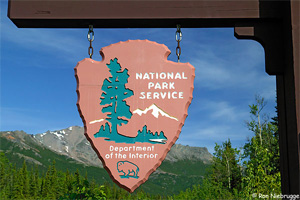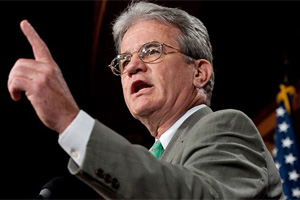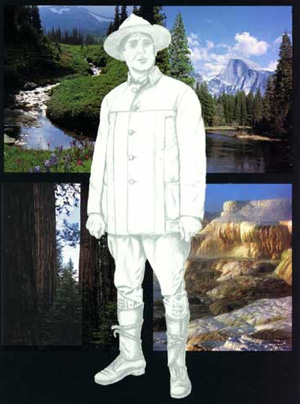 (WASHINGTON, D.C.) – U.S. Senator Tom Coburn, M.D. (R-OK), Ranking Member of the Homeland Security and Governmental Affairs Committee, released a report entitled, “PARKED! How Congress’ Misplaced Priorities are Trashing Our National Treasures.” The report documents how members of Congress have used the Park Service to advance parochial interests while ignoring billions in maintenance backlog at our nation’s most prized national parks, and outlines areas of low-priority and wasteful spending by the Park Service.
(WASHINGTON, D.C.) – U.S. Senator Tom Coburn, M.D. (R-OK), Ranking Member of the Homeland Security and Governmental Affairs Committee, released a report entitled, “PARKED! How Congress’ Misplaced Priorities are Trashing Our National Treasures.” The report documents how members of Congress have used the Park Service to advance parochial interests while ignoring billions in maintenance backlog at our nation’s most prized national parks, and outlines areas of low-priority and wasteful spending by the Park Service.
“Instead of proposing new national parks on the moon, Congress should be focused on restoring our decaying national treasures right here on earth. Long before the government shutdown and sequestration, our parks had become a physical manifestation of Congress’ dysfunction,” Dr. Coburn said.
 “For years, members of Congress on both sides of the aisle have put their parochial desires ahead of the nation’s best interest. Funding for low-priority and obscure parks earmarked by lawmakers has come at the cost of caring for our national treasures like the Grand Canyon, Yellowstone, the National Mall and Independence Park in Philadelphia. Last year alone, the National Park Service put off more than a quarter billion dollars in much needed maintenance projects, adding to the $11.5 billion maintenance backlog already threatening the health, safety, and accessibility of park visitors. I hope this report inspires my colleagues to set common sense priorities and make sure our parks reflect our nation’s greatness rather than Washington’s incompetence.”[/caption]
“For years, members of Congress on both sides of the aisle have put their parochial desires ahead of the nation’s best interest. Funding for low-priority and obscure parks earmarked by lawmakers has come at the cost of caring for our national treasures like the Grand Canyon, Yellowstone, the National Mall and Independence Park in Philadelphia. Last year alone, the National Park Service put off more than a quarter billion dollars in much needed maintenance projects, adding to the $11.5 billion maintenance backlog already threatening the health, safety, and accessibility of park visitors. I hope this report inspires my colleagues to set common sense priorities and make sure our parks reflect our nation’s greatness rather than Washington’s incompetence.”[/caption]
Key findings include:
 • Despite a total allocation of $2.6 billion to the National Park Service, Congress again underfunded the maintenance portion of the budget – this year by $256 million, meaning more will be added to the already enormous $11.5 billion deferred maintenance backlog
• Despite a total allocation of $2.6 billion to the National Park Service, Congress again underfunded the maintenance portion of the budget – this year by $256 million, meaning more will be added to the already enormous $11.5 billion deferred maintenance backlog
• The top ten most visited park units in 2012 had a deferred maintenance backlog of $2.6 billion
• Yosemite and Yellowstone National Parks combine to $1 billion in deferred repairs alone, while Washington DC’s National Mall and Memorial Parks’ backlog stood at $530 million as of 2012
• Of the top 25 most visited National Parks in 2012, only 8 have been approved since 1970 – of the 25 least visited parks, 20 have been established since 1970
Despite a constantly growing maintenance backlog, Congress continues to spend money on non-essential items and a massive overhead
• The water supply on the south rim of Grand Canyon National Park is dependent on a transcanyon pipeline that was installed nearly 50 years ago. It has deteriorated to a point where ruptures “have become more frequent,” and in order to save water during pipeline breaks, “water from the creek is used for flushing toilets and disposable plates are used at the cantina for meals.”
• The backlog of the trails at Grand Canyon NP alone total over $24 million, and “unless management actions are taken in the near future, trails will continue to fall into disrepair and deferred maintenance costs will continue to increase.”
• At Independence National Historic Park in Philadelphia, “the majority of the park’s walkways were constructed or renovated between 1950 and 1976” and contain many tripping hazards. Over the last 5 years, tripping hazards in the park have resulted in 15 tort claims filed leading to claims ranging from $200,000 to $2 million per year.
• The 60 to 80 year old water system in a portion of Yellowstone National Park loses about 50 to 70 percent of the system’s water through leaks, with reports of leaks as large as “15,000 gallons per day, per joint of pipe.” The existing lines fail to “provide adequate fire protection to the facilities of the historic district,” while “end lines and cross connections can create contamination or restrict disinfection in the drinking water system.”
• Potholes in Mammoth Cave National Park, the world’s longest known cave system, have caused safety concerns for visitors and the elevator used to provide access to mobility impaired visitors has been closed for over a decade after the elevator’s cables broke and a park ranger got stuck inside.
• An outdated utility system in California’s Lassen Volcanic National Park requires constant repair including 2,500 hours in emergency labor in a single year.
• Areas of Gateway National Recreation Area remain closed eight years after radioactive soil was discovered
• At $1.36 billion in Fiscal Year 2012, the amount budgeted for operations at the 401 park units constitutes barely half of the $2.6 billion in appropriations provided to NPS by Congress
• Limited resources are instead spent on items such as wine trains, Elvis boats, neon sign restoration, teachers’ symposiums, car shows, DC area-concert subsidies, folk festivals, inflatable fair rides and video game production
• Congress continues to spend between $255 and $529 million annually for more land despite the inability to care for the federal property we already own
• For example, the federal government plans to spend $107 million to add 1366 acres to the 310,000 acre Grand Teton National Park, expanding the Wyoming park unit by one percent – the same amount of funding could have reduced the park’s $221.7 million deferred maintenance backlog by nearly 50 percent
• NPS has a massive bureaucracy, consisting of $623 million for administrative or specialty support offices and administrative costs, equating to $1.5 million in overhead for each of the 401 park units($1.55 million average in support costs per unit is more than the amount provided annually for more than 150 individual park units)
Since the 1970s, Congress has abused NPS to add parochial projects at the cost of tending to the true national treasures
• Of the top 25 most visited National Parks in 2012, only 8 have been approved since 1970 – of the 25 least visited parks, 20 have been established since 1970
• Originally composed of 35 park units, the NPS’s responsibilities has since expanded to 401 park units covering over 84 million acres of land in all 50 states, Washington DC, four U.S. territories, and Canada
• Congress and the administration have added many park units on a parochial or political basis that have little national significance
• In 1978, a single legislator seeking a leadership position in the House forced through a pork-laden park service bill that continues to cost $37 million annually today
• There are 14 park units that cost more than $100 per visitor to operate – 12 of those were established since 1970
• These parochial parks dilute the resources available to tend to the true national treasures, that are suffering from Congressional neglect
• The behavior continues today – despite a $256 million shortfall in maintenance funding and an $11.5 billion backlog, more than 35 bills have been introduced this year to study, create or expand national parks, monuments and heritage areas, including a bill to establish a national historic park on the moon.
